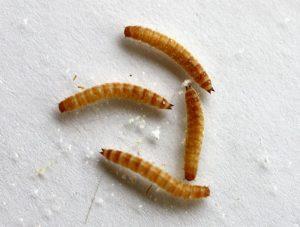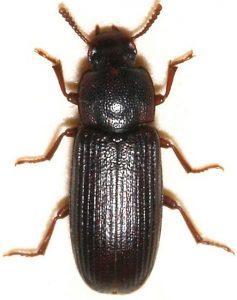Destructive flour beetle of the darkling beetle family is commonly known as flour beetles. They cause immense destruction to flour, which in turn is a result of their name.
Size: 5 – 6 mm (0.19 – 0.23 inches)
Color: They have an overall brown body.
Other Characteristic Features: They have a flat, hard body with slightly indented antennae.
The larvae appear slightly cylindrical with a reddish-brown body mostly found in flour or grain containers.

Not much detail is recorded about the pupae. However, they gradually turn brown, replicating an adult beetle.
The eggs, too, like the larvae, are white with a cylindrical shape.
| Other Names | Dark flour beetle |
| Adult lifespan | 4 – 8 months |
| Duration of larval stage | Not recorded |
| Distribution | Europe, Africa, North America |
| Habitat | Granaries, pantries, or kitchens where flour and grains are stored |
| Predators | Not recorded |
| Seasons active from | Not recorded |
| Diet of larvae and adults | Flour, grain, poultry feed, rolled oats |

They do significant damage to the flour alongcol3 other food grains by infesting them. In this manner, they hamper the taste and smell of the flour immensely, making it unfit for use.
Image Source: biochemtech.eu, upload.wikimedia.org, live.staticflickr.com, bugguide.net, i.pinimg.com
Destructive flour beetle of the darkling beetle family is commonly known as flour beetles. They cause immense destruction to flour, which in turn is a result of their name.
Size: 5 – 6 mm (0.19 – 0.23 inches)
Color: They have an overall brown body.
Other Characteristic Features: They have a flat, hard body with slightly indented antennae.
The larvae appear slightly cylindrical with a reddish-brown body mostly found in flour or grain containers.

Not much detail is recorded about the pupae. However, they gradually turn brown, replicating an adult beetle.
The eggs, too, like the larvae, are white with a cylindrical shape.
| Other Names | Dark flour beetle |
| Adult lifespan | 4 – 8 months |
| Duration of larval stage | Not recorded |
| Distribution | Europe, Africa, North America |
| Habitat | Granaries, pantries, or kitchens where flour and grains are stored |
| Predators | Not recorded |
| Seasons active from | Not recorded |
| Diet of larvae and adults | Flour, grain, poultry feed, rolled oats |

They do significant damage to the flour alongcol3 other food grains by infesting them. In this manner, they hamper the taste and smell of the flour immensely, making it unfit for use.
Image Source: biochemtech.eu, upload.wikimedia.org, live.staticflickr.com, bugguide.net, i.pinimg.com